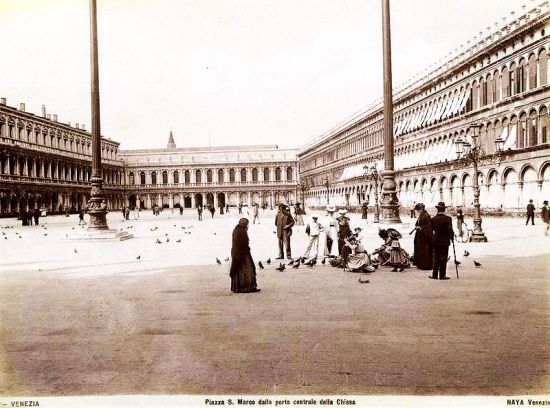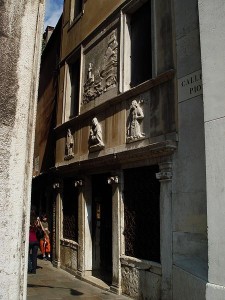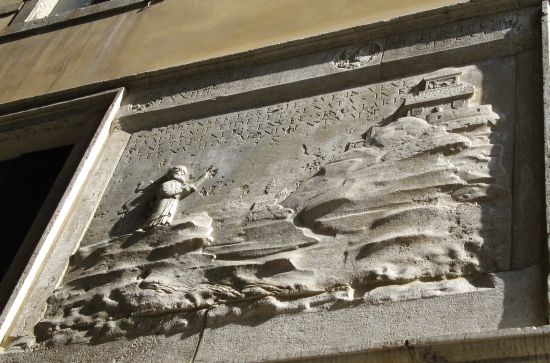

Talk about Venetian history long enough — say, eight minutes, or even fewer — and you will almost certainly refer at least once to Napoleon Bonaparte. If you are somehow able to avoid mentioning him, you should embed the secret in a cellphone game because I think it would be a challenge.
And why is this? Because on May 12, 1797, his army entered Venice and the Venetian Republic fell forever. That was one day. Then the damage really began.
Napoleon craved Venice for several reasons, one of which was that it was the richest city in Europe. He needed money to pay for his wars, and when he was done, the city was eviscerated of tons of art works, precious metals, and gems. His soldiers spent two weeks carting treasures out of the basilica of San Marco. What he stripped from the “Bucintoro,” the doge’s state barge, was enough to keep most of us in Kobe steak for the rest of our lives.
Even if you didn’t know that, you walk through his handiwork in the course of any ordinary stroll here — through campos named for saints whose churches are nowhere to be found, for example — because the Venice we see today is the result of months of devastation wrought upon the city in the fulfillment of his ideas.

If you want to try to imagine the city before it was disemboweled (I often try, and usually fail), here is a partial list of the buildings Napoleon got his hands on. My source is “Storie delle Chiese dei Monasteri delle Scuole di Venezia Rapinate e Distrutte da Napoleone Bonaparte” by Cesare Zangirolami (Filippi Editore – Venezia). Some of these structures were completely demolished, some merely gutted and abandoned, or decommissioned, so to speak, like sinking battleships, and used as warehouses (coal, tobacco, etc.) or assorted other really practical purposes, such as barracks. A few have been restored and resuscitated, but not to their former use — you’ll recognize the names of some you’ll have at least walked past. This list does not include the 80-some palaces he razed. Nor the tombs of doges and patricians which have disappeared. But the book does list each work of art which is gone forever.
Abbey of San Cipriano
Churches:
Dell’Anconeta. Sant’Agnese, Sant’Agostino, Sant’Anna, Sant’Antonio Abate, Sant’Anzolo, Sant’Apollonia, Sant’Aponal, dell’Ascensione, San Basegio, San Basso, San Bernardo, San Biagio, San Biagio e Cataldo, San Boldo, San Bonaventura, Cavalieri di Malta, della Celestia, delle Convertite, del Corpus Domini, della Croce, della Croce alla Zuecca, San Cataldo, Santa Chiara, Santa Chiara di Murano, Santi Cosma e Damiano, San Daniele, San Domenico, Sant’Elena, Santi Filippo e Giacomo, San Geminiano, San Giacomo di Rialto, San Giacomo della Zuecca, San Giovanni Battista, San Giovanni Battista dei Battuti, San Giovanni dei Furlani, San Giovanni Laterano, San Girolamo, San Giuseppe di Murano, Santa Giustina, della Grazia, San Gregorio, Santa Lena, San Leonardo, San Lorenzo, Santi Marco e Andrea, Santa Margarita (sic), Santa Maria Annunziata, Santa Maria Celeste, Santa Maria degli Angeli, Santa Maria della Carita’, Santa Maria delle Grazie, Santa Maria delle Vergini, Santa Maria del Pianto, Santa Maria Maddalena, Santa Maria Maggiore, Santa Maria Nova, Santa Marina, Santa Marta, San Martino Vescovo, San Matteo Apostolo, San Matteo di Murano, San Mattia, San Maurizio, San Michele Arcangelo, San Nicoletto della Lattuga, San Nicolo’ di Bari, Ognissanti, San Paternian, San Pietro Martire, San Provolo, del Santo Sepolcro, dello Spirito Santo, San Salvador di Murano, Santa Scolastica, San Sebastiano, San Severo, Santa Sofia, San Stefano di Murano, San Stin, Santa Ternita, della Trasfigurazione, della Santissima Trinita’, dell’Umilta’, San Vio.
Islands (not the islands themselves but the edifices upon them) :
Sant’Andrea, la Certosa, San Cristoforo della Pace, San Giorgio in Alga, della Grazia, San Secondo.
Monasteries: (in some cases the structures remain and are even in use, but he dismembered their congregations, some of which were admittedly small, but still. I’ve been to many offices which are housed in former convents and cloisters).
Sant’Anna, Sant’Antonio Abate, San Bernardo, Santi Biagio e Cataldo, Santa Chiara di Murano, Santi Cosma e Damiano, della Croce, San Daniele, delle Dimesse, San Domenico, San Francesco della Vigna, San Giacomo, San Giovanni Battista, San Giovanni Laterano, San Giuseppe, San Lorenzo, Santi Marco e Andrea, Santa Maria degli Angeli, Santa Maria dei Servi, Santa Maria delle Vergini, Santa Maria del Pianto, Santa Maria Maddalena, San Martino Vescovo, San Matteo, San Mattia, San Michele di Murano, San Pietro Martire, del Santo Sepolcro.

Oratorio della Concezione, Oratorio di Sant’Orsola.
Ospitale degli Incurabili, Ospitale dei Marinai.
Patriarcato (at San Pietro di Castello, the palace of the Patriarch of Venice till 1807, when San Marco was made the city’s cathedral).
Priorato (Priory) di Malta
Scuole (headquarters of the many guilds and confraternities):
degli Albanesi, della Carita’, San Francesco, San Girolamo, San Giovanni dei Battuti, San Giovanni Evangelista, della Madonna della Pace, San Marco, Santa Maria e Cristoforo, dei Mercanti, della Misericordia, del Nome di Gesu’, dei Pittori, della Santissima Trinita’, dei Stampatori e Librai, San Stefano, San Teodoro, dei Varoteri.
And people talk about Attila.


10 Comments
I can’t help saying Napoleon’s name without following on with the words ‘the b*****d’. It’s horrific to see his desruction listed here. I’ve never seen it written down before. Weren’t the French recently supposed to pay to have the Bucintoro rebuilt as a gift to Venice? Guilty consciences!
The subject of the rebuilding of the Bucintoro is another cat’s-cradle of characters and half-baked ideas. (Yes, there is an ongoing effort to rebuild it, but I don’t believe the French are any part of it. If the French were to try to make reparations for everything Napoleon did, there will, in fact, be no end to it.) There was a French committee some while back that got all excited about having found, they claimed, the statue of Napoleon which he had had made and had intended to be placed in the center of the architrave of the “Ala Napoleonica.” They were all keen to put it in its long-empty proper place, and seemed to think this was an idea that Venetians would greet with the enthusiasm due any worthy long-lost work of art. The enraged outcry buried the idea for what I hope will be forever, though I don’t know if they ever grasped what was so wrong with their offer.
🙁 so much lost..
I agree so completely with everything Andrew said about Napoleon! The list blew my tiny mind away, let me tell you.
That French committee displayed an exceedingly high degree of sensitivity, didn’t they? Mind you, the statue could have replaced the lad and his frog on the Punta della Dogana, but without the security presence. Then, it could become an interesting site for officially sanctioned graffiti.
Mussolini also shuffled things around a bit, didn’t he?
I wouldn’t have called it “shuffling,” though I sense you are being sprightly when you say that. Yes, Mussolini caused a number of major changes in the Venetianscape: In just a few of the years of the Thirties he caused to be built The highway tbridge attached to the railway bridge, Piazzale Roma, the Rio Novo, and the Riva dei Sette Martiri (which people Lino’s age still refer to by its original name: Riva dell’Impero, or Riva of the Empire). Except for the bridge, these innovations required the destruction of swaths of buildings. Most of them were houses. That doesn’t make the process “better” than what Napoleon did, but I can’t undertake a history of the transformations of the city, which has undoubtedly already been done. I didn’t mean to imply that Napoleon was the only person who did cutting and pasting here. Just that he was the first and, in my opinion, the worst, partly because what he destroyed was intended to emphasize the fact that he not only had conquered, but wished to humiliate, the city.
Well, that’s certainly not the Napoleon I learned about at school in Paris or Algiers! My husband, who represents the English view, and I have had heated discussions about the little corporal. Thank you for the listing and especially the painting of San Geminiano–it makes the devastation so real.
I can see how your Francophone (I presume they were) teachers kind of left that out. If I ever find the time, I’ll attempt to recount the steps by which he drove Venice to its knees, then set up a “Liberty Tree” in the Piazza San Marco to represent the freedom from oppression which he had bestowed on the suffering citzenry. Venetians passing it went “WTF? We were fine just the way we were — we had no idea we needed to be liberated.” It didn’t stay up very long.